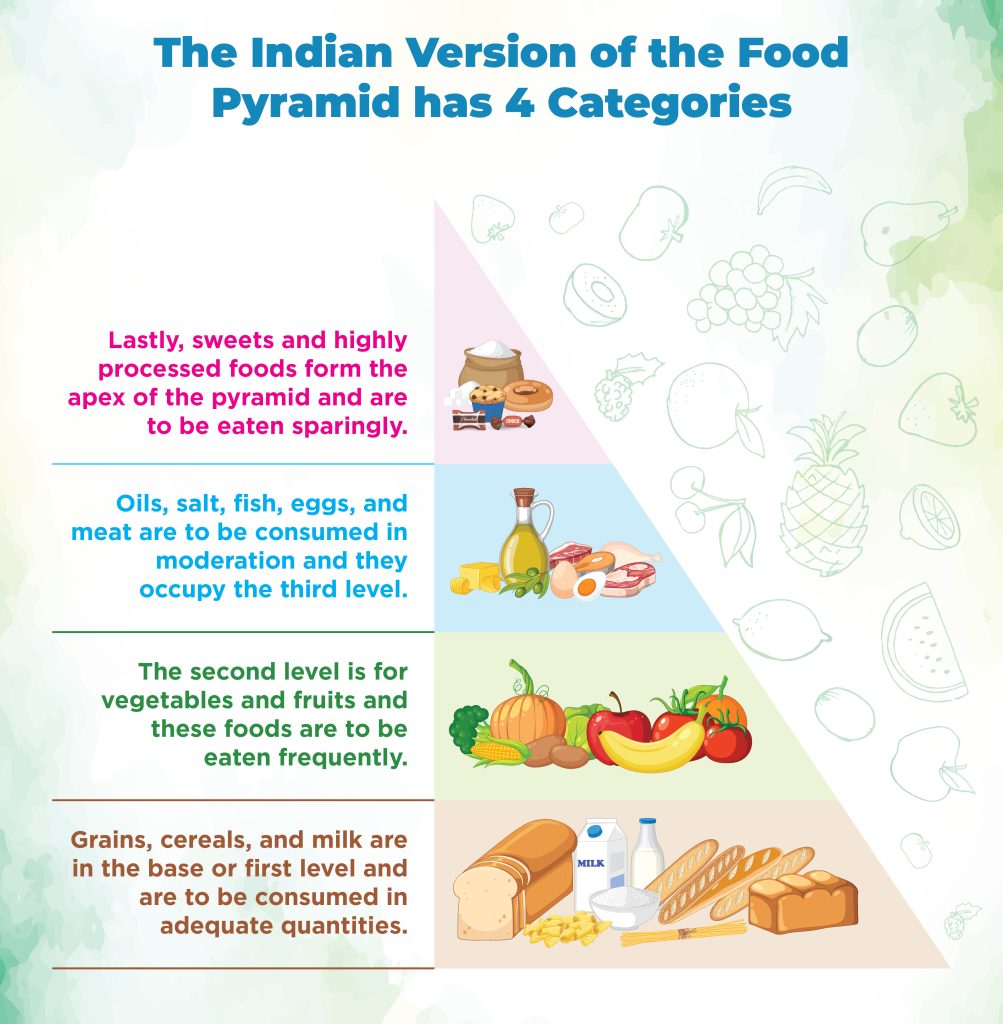The Indian Food Pyramid: Guiding people to eat healthy since 1970.
We are what we eat, they say. Indeed, what we put inside our bodies determines our health. To that end, the food pyramid has served as a guide to balanced eating for years. A food pyramid is a visual representation of the optimal servings of food that one should consume from each food group. This information is arranged in the form of a pyramid which is how the method derives its name.
The origin of the food pyramid could be traced back to the 1970s when it first evolved in Sweden. In 1992, the US Department of Agriculture also adopted it with minor tweaks. Since then, many countries have adopted various versions of the food pyramid to guide their citizens in adopting healthy diets.
What’s in a food pyramid?
The food groups that comprise a healthy eating pyramid include whole grains, dairy, supplements, nuts and seeds, meat and poultry, vegetables and fruits, and healthy oils, among other categories.
There are additional sections related to exercise or alcohol consumption that are included by some countries in their food pyramids. The tool has helped countries across the world guide people on various aspects of health like weight control, multivitamin supplements, exercising, and deficiency of nutrients like Vitamin D.
According to the pyramid, one should consider whole grains as the primary dietary source, followed by fruits and vegetables. The pyramid guide suggests moderation while consuming meat, fish, poultry, milk, and their alternatives while reducing fats, oil, salt, and sugar intake. The guide also suggests that people prefer cooking techniques that require less oil or opt for low-fat recipes. People can also choose to steam, stew, simmer, boil, or even cook with non-stick cookware to reduce their oil consumption.
The Indian version of the food pyramid
The Indian version of the food pyramid has four categories:

There are some additional guidelines also mentioned:
- Ample food and healthcare should be ensured for children and adolescents.
- One should eat a variety of foods for a balanced diet and avoid overeating.
- The diets of elderly people should include foods that are rich in micronutrients.
- One should drink plenty of water.
- Ensure the consumption of safe and clean foods.
Why do we need a food pyramid?
One of the reasons why the food pyramid became a popular tool among healthcare educators and medical experts was because it helped people consume the right foods. As different foods have different nutrients, it might not be possible to derive all required nutrients from a single source.
The diet suggested by the pyramid requires people to eat foods from all groups so that they meet their body’s daily nutritional requirements.
The second reason is that it advises people about the right quantities of different foods to be consumed. Both eating too much or too less can lead to adverse health outcomes. A dedicated guide like a food pyramid can help us ensure that we are consuming the right foods in ample quantities.
The debate around food pyramids
While the food pyramid has served as a useful dietary tool in educating people about their nutritional needs, it has also been subjected to a lot of debate for not being customizable. There is a section of experts who have argued that the food pyramid of a country might not be suitable for all its citizens due to factors like geography, access to food, and weather.
The creators of the food pyramid have also drawn flak for “oversimplifying” the concept of the “ideal diet”. They have also been criticized for not educating people about how to differentiate between carbohydrates and instead only focusing on the number of servings. Likewise for fats. Different fats have varying nutritional profiles. In most food pyramids, people are advised to consume fats in lesser quantities. However, this categorization ignores the fact that unsaturated fats are healthier than saturated fats and are essential for maintaining good health.
Conclusion
Nevertheless, the food pyramid can be a good starting point for anyone who’s looking to lead a fitter lifestyle. All of us need a specific quantity of nutrients every day to maintain good health. The overconsumption or underconsumption of any of these nutrients will only hamper our health. Therefore, the food pyramid can serve as a handy tool for knowledge about how a healthy diet should be planned.





